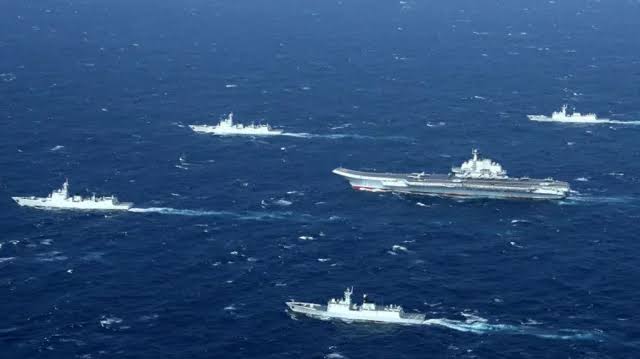Taiwan Strengthens Naval Presence Amid Escalating China Standoff
Escalating tensions in the Taiwan Strait have reached a critical juncture as Taiwan’s Ministry of National Defense (MND) reported a significant surge in Chinese military activity, prompting the island to deploy naval forces and coastal missile systems in response. On Saturday, the MND detected 14 Chinese military aircraft, nine naval vessels, and one official ship operating around Taiwan until 6 a.m. local time, with nine aircraft crossing the median line into Taiwan’s northern and eastern Air Defense Identification Zone (ADIZ). This follows a pattern of intensified Chinese incursions, with 47 aircraft and multiple vessels tracked over the past 24 hours, signaling one of the largest maritime operations since the 1996 Taiwan Strait Crisis.
Taiwan’s armed forces have responded decisively, deploying warships like the guided-missile destroyer Ma Kong DDG1805, patrol aircraft, and mobile missile groups to monitor and counter the People’s Liberation Army (PLA) activities. The MND condemned China’s actions as “unilateral provocations” that threaten regional stability, stating, “We have monitored the situation and responded accordingly to protect our sovereignty.” Taiwan’s 10-day Han Kuang military exercises, which began on July 9, are also underway, focusing on repelling simulated Chinese landings and countering “gray zone” tactics, with 22,000 reservists backing regular forces.
China’s aggressive posture, involving nearly 90 navy and coast guard ships stretching from southern Japan to the South China Sea, aims to assert dominance over the Taiwan Strait, potentially transforming it into an “internal sea,” according to Taiwanese intelligence officer Lt. Gen. Hsieh Jih-sheng. The PLA’s deployment includes guided-missile frigates, destroyers, and aircraft carriers Liaoning and Shandong, with recent patrols near Scarborough Shoal indicating broader regional ambitions. This escalation coincides with Taiwanese President Lai Ching-te’s Pacific tour, including U.S. stops, which Beijing denounced as “separatist.” Lai has warned of China’s intent to annex Taiwan as part of its “great rejuvenation” policy, a goal underscored by Chinese President Xi Jinping’s directive to prepare for potential military action by 2027.
The United States, Taiwan’s primary arms supplier, condemned China’s actions as “irresponsible” and destabilizing, with the State Department reaffirming support for Taipei’s security. U.S. Secretary of Defense Pete Hegseth, speaking at the Shangri-La Dialogue, warned that a Chinese attack “could be imminent,” though President-elect Donald Trump has remained ambiguous on defending Taiwan, prioritizing negotiations. Japan, a key regional ally, scrambled fighters in response to a Chinese UAV circling near Taiwan, while the Philippines criticized China’s “illegal presence” in Southeast Asian waters.
Posts on X reflect global alarm, with @ianellisjones noting a fourfold increase in PLA aircraft incursions in February 2025 compared to 2024, and @Currentreport1 highlighting China’s deployment of seven “air reserves zones” as a threat to Taiwan. Public sentiment ranges from concern over a potential invasion to calls for diplomatic de-escalation. Analysts, including J. Michael Cole of the Global Taiwan Institute, warn that China’s unannounced maneuvers aim to exhaust Taiwan’s defenses through ambiguity, complicating responses from Taipei, Tokyo, and Washington.
As Taiwan bolsters its asymmetric defenses, including U.S.-supplied F-16V jets and high-caliber rockets, the international community watches closely. NATO’s Mark Rutte raised concerns about a possible China-Russia alliance targeting Taiwan, potentially escalating global tensions. With China’s $231.36 billion defense budget dwarfing Taiwan’s, the island’s strategy hinges on deterrence and international support. As both sides brace for further developments, the Taiwan Strait remains a flashpoint with far-reaching implications for Indo-Pacific stability.
